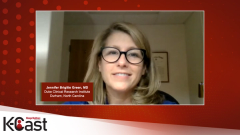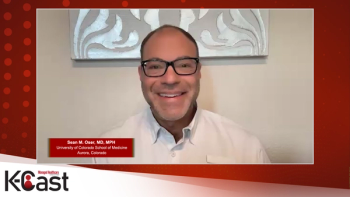
AMCP Nexus 2021 Updates on iGlarLixi in Type 2 Diabetes
An expert in endocrinology reviews updates from the AMCP Nexus 2021 conference on treatment persistence and adherence with iGlarLixi versus free-dose combinations of basal insulin and GLP-1 receptor agonists, and shares insight on future directions for disease management.
Episodes in this series

Rodolfo J. Galindo, MD: So far, we have been discussing how interesting a combination of basal insulin and GLP-1 [glucagon-like peptide-1] agents is. I applaud all the companies that decided to put effort into developing these new agents, and doing many studies, a really big portfolio of study with a lot of effort into that. And they were complementary. Then we discussed the validating studies for iGlarLixi [insulin glargine, lixisenatide] and for IDegLira [insulin degludec, liraglutide], the 2 agents that are available in the market. Then we discussed the studies that compare these agents in patients who are insulin naïve, not previously treated with insulin, and uncontrolled on oral agents. But then also we compared these agents to premixed insulin, which is commonly still used unfortunately, for many of our patients.
Now, I want to talk about something that is important to clinicians, of course, but I don’t think that patients see it as really important. I think it is actually a better metric for payers than for patients, which is adherence to therapy and persisting on X, Y therapy. The best treatment is not what will give you the better outcome, it is the treatment that the patient will use. And when you’re sitting in the office and you have a patient with type 2 diabetes, high blood pressure, a prior MI [myocardial infarction], kidney disease, and sleep apnea, or COPD [chronic obstructive pulmonary disease], and they’re taking 20 medications or 15, you need to face that patient and tell them that, “You need to take more medications now.” Remember, simplicity and agents that are complementary makes a lot of sense to us, but patients don’t see it, you need to explain that.
This was a very interesting poster that was presented at the Academy of Managed Care Pharmacy [AMCP], last year, 2021. The study observed the adherence and persistence of treatment with iGlarLixi versus its free combinations. This is very commonly seen. Insulin glargine has really good coverage, and we have been using it for a long time, so it tends to be an easy option for many clinicians. Then lixisenatide also, or other GLP-1s. But the point is that when you combine them, you get much better benefits. We can discuss that, an hour discussion, but more importantly, you are simplifying; you’re making simpler options for your patients. This study compares, again, iGlarLixi with the free-dose combination of basal insulin and lixisenatide, a GLP-1 receptor agonist, and it was presented by Lawrence Casalino, MD, et al, in 2021. The key point from this study is that a higher proportion of patients who were treated with iGlarLixi were persistent and adherent versus those treated with the free-dose combination.
If you ever wonder why your patient is not controlled, it is not your patient’s fault, it is never your patient’s fault. It is nobody’s fault, but you need to be more innovative and creative and try to find a way to have that patient be adherent and use their therapy as it is supposed to be used. It’s very hard for patients to do complex treatment regimes, even if they are really good at reducing A1C [glycated hemoglobin]. That’s very interesting to know. And we have many studies showing that patients treated with GLP-1 agents, they don’t tend to stick to it long term; 50% to 70%, some studies have suggested, of patients stop taking this medication. When you combine them, the adverse effects and the dose and everything is complemented by the basal insulin, so you have a better effect with lower doses sometimes. Some patients tend to be more adherent, and this study confirmed that, better adherence and better persistence. That was very interesting.
But then, you wonder why we need to know that. It is important for patients, and I keep saying that. But also, this study, which is very interesting, showed that it lowers costs, lowers pharmacy costs. Again, a fixed-ratio combination, simpler injection, once a day, complementary actions. You are always wondering, because it’s a new medication, is it going to be more expensive? The reality is that the pharmacy cost of this fixed-ratio combination, when you compare that to the individual components, was lower. It was very interesting to me to know that, and I think it’s important data for the payers. Also, you control the A1C, but that actually is not what is translated long term. It’s important to look at other stronger outcomes. For example, in this study, patients treated with iGlarLixi had fewer hospitalizations and fewer emergency department visits compared to those treated with the free-dose combination of these agents. It seems to be just simpler and common sense, when you combine them, they tend to work better.
I was very impressed by that, and I think it is very helpful for patients, but it’s important for payers to know that. Adherence has been shown to result in better care, fewer acute complications and fewer hospitalizations. When your patients are adherent to the treatment, you will have better outcomes long term. And it’s not that I’m telling our payer colleagues to do something and what they need to do, it is just showing evidence-based coverage modification. I don’t see a benefit, I don’t see a reason, and I don’t have any evidence to say that premixed insulin should have better coverage than fixed-ratio combinations. Nor do I see a reason why you have better coverage and lower out of pocket costs for the free-dose combination of these agents, basal insulin and GPL-1, and not for the fixed-ratio combination; it is just simpler. I think that these data are very helpful for those who make decisions, and we share this with patient advocacy groups as well. We’ll be sharing that with them.
This study that was presented at the AMCP by Casalino, et al, in 2021, shows that the use of fixed-ratio combination, specifically the study was iGlarLixi, was a better option than either of these components alone. It was better than mixing insulin in another study published in Diabetes Care by Julio Rosenstock, MD, and it’s a really good option for patients not controlled on basal insulin and oral therapy. I would encourage clinicians to consider this and would also encourage our colleagues from pharmacy, and health care systems, and insurance to use this evidence to support their coverage decisions. Also, talking about what is going to be happening in the future and how these data are going to be impactful, I was very excited, because when you do a clinical trial, and I do many of them, it is not always what I see in my practice. We always need real-world data, and this study was real-world data. It’s always good to have data from the daily work and not just a clinical trial, which is a very monitored environment where patients are most of the time compliant.
These real-world data show that the fixed-ratio combination has better adherence or persistence of therapy. Very interesting, I think that patients with a hemoglobin A1C of more than 9%, up to 10%, had really good results. It needs to be validated, but we clinicians know that patients treated with multiple daily injections of basal plus bolus insulin, most of these patients have an A1C of more than 10%. And for years, we have been saying that this is the best therapy for them. I strongly believe that’s not the case. I think that a fixed-ratio combination is probably the best option for a patient with really high A1C. They will be more compliant. This is just a simple comparison, but consider 3 injections a day or 4 injections a day compared to 1 injection per day. It just make sense for patients and clinicians to use a fixed-ratio combination. I believe that multiple daily injections of basal, bolus insulin for type 2 diabetes will be dying soon. In the future, we have a better option for these patients. Not for everybody, some patients don’t make insulin at some point in their disease course, but not as many as we used to treat in the past. And this is recommended by the guidelines, actually.
Type 2 diabetes is a really complex disease with many different pathophysiological defects, the so-called ominous octet, so many different pathophysiological defects. Using 1 agent is very unlikely to solve the problem. You need to use an agent that has complementary actions. I don’t see a value in using insulin therapy with insulin secretagogues, because they work on the same action, they just increase insulin levels. From my thinking it doesn’t make sense, and we see it all the time in practice. Combining agents that have complementary actions is much better. And of course, agents that can counteract those potential adverse effects from medication. For example, for basal insulin, it is weight gain. If you use a GLP-1, you’re trying to decrease that. For insulin, it is hypoglycemia, and when you use a GLP-1, you decrease the amount of insulin needed and then you tend to have lower hypoglycemia. That was the data that we discussed.
The future of type 2 diabetes is going to be combining agents with complementary actions. If you combine them into 1, it is much better than if you need to take 2 or 3 individual doses. We discussed that the combination is much better than the use of these individual components. And I’m pretty sure that we’ll be using most of these combined therapies. I think that is really helpful for patients. We have strong data to support that it results in less complication, less hypoglycemia, weight loss, and more importantly, patient adherence. Patients tend to be more adherent with the fixed-ratio combination therapy than when they take both components individually.
Transcript Edited for Clarity
Newsletter
Get the latest industry news, event updates, and more from Managed healthcare Executive.
















































